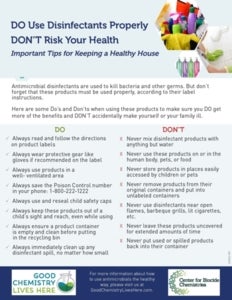This is a time of unprecedented anxiety and uncertainty, with far more questions about the Coronavirus than there are answers. One point of certainty, however, is the ability of antimicrobial disinfectants to help kill and stop the spread of viruses like COVID-19. In fact, there are more than a thousand products that people can use to disinfect their home, office, vehicle, or other surroundings.
But it is extremely important that consumers use these products the right way, strictly according to the instructions printed on the label. It can be easy to think that a disinfecting spray or wipe available at any grocery store can’t possibly be dangerous to use. And in fact, these products, which are extensively tested, examined, and regulated, are indeed safe for use – as long as they are used the way they were intended.
The problem arises when people are not aware of how a product should be used and, more importantly, how it should not be used. It might seem logical to think that if a spray is effective at killing germs on a kitchen counter, then spraying an apple might help to prevent a food poisoning illness. Unfortunately, this is not necessarily the case, and in fact, this person could be ingesting a chemical that may be labeled as not safe for human or animal consumption.
There are other important considerations when using disinfectants as well. It is imperative that such household products not be left out in areas accessible to children or pets. Nor should disinfectants be taken out of their containers and put into unlabeled bottles or jugs. Users should wear gloves or dilute products if directed to on the label.
There are many valuable lessons to keep in mind when using disinfectants, or any chemical-based product. In response to a CDC report and news articles last month regarding a recent increase in accidental poisonings, the Center for Biocide Chemistries (CBC), whose members include the manufacturers of many top-selling disinfectants, has produced an infographic providing guidance on how to use, and how not to use, these products.
The piece, titled “DO Use Disinfectants Properly, DON’T Risk Your Health: Important Tips for Keeping a Healthy House,” is a combination of common sense tips and more nuanced advice of which the average person may not be aware. For instance, it may seem reasonable to take partially filled bottles of different disinfectants and combine them into one, but there are potential dangers of mixing chemicals. A person might spill a household product on the kitchen counter and opt to clean it up later, only to forget and prepare food in the same spot.
Ultimately, the top priority espoused by the CBC in its new brochure is that you must read and follow the label instructions on all of your disinfectant products. These labels will provide guidance on how the products should be used, stored, and disposed of safely.
Disinfectants are important tools in the fight against the spread of COVID-19. They are truly effective at ridding our homes and surroundings from germs that can make us sick. But it’s important that we use them the right way, and the CBC remains dedicated to providing guidance and information to help emphasize the benefits of using disinfectants properly.
For more information, please visit https://goodchemistryliveshere.com/.
